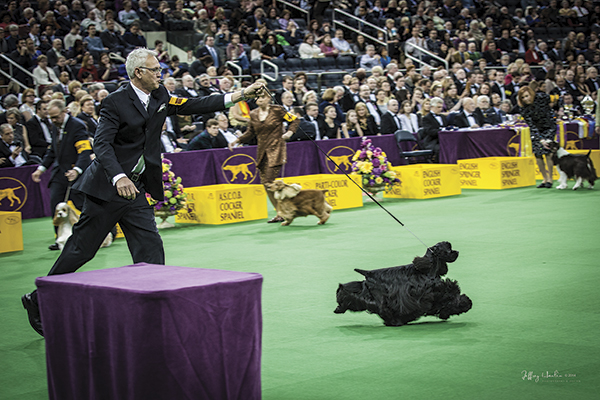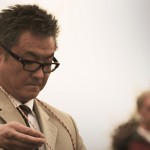BIS: First of all I would like to thank you for taking the time to do this interview. You have bred healthy and typey American Cocker Spaniels for generations now. How did you get started with American Cockers and why?
L.M.: Thank you for asking me. I had a cocker spaniel when I was growing up and after I graduated from law school, I knew I wanted a cocker as a pet. In looking for a pet cocker, I met a lady that showed cockers, I bought one and I became hooked.
BIS: Which dog do you consider the foundation of your own breeding program?
L.M.: CH. Casablanca’s High Five. He was a son of CH. Glenmurray’s High Noon.
BIS: What do you consider your greatest achievement in showing?
L.M.: My greatest achievement in showing cocker spaniels has been breeding the litter that includes GCH Casablanca’s Thrilling Seduction – Beckham. Besides Beckham, who is the top BIS-winning sporting dog in the United States and was the No. 1 Dog All-Breeds in 2011, the litter included 3 other champions, one who was also a Sporting Group Winner and another who was a Best in Specialty Show winner, and an obedience champion who is still showing in obedience.
BIS: How many dogs do you have at home (living with you) and how many you coown? How many litters approximately you have a year?
L.M.: I have 5 American cocker spaniels living with me at this time and I co-own two more that do not live with me. I have not had a cocker litter in approximately 4 years, but Linda Pitts and I have co-bred a litter that is due in 2 weeks, so I am very excited.
BIS: Please mention 2 or 3 American Cockers which are not owned, bred or shown by yourself, that you particularly admired, and tell us what you most admired about each.
L.M.: Because I breed black cockers I tend to think first of black cockers: CH Frandee’s Forgery, CH Glenmurray’s Solid Black, CH Westglen Blak-Gammon and CH Sweetheart’s Space Jam, but CH San Jo’s Born To Win, a parti-color, also stands out. They all had beautiful movement and breed type.
BIS: With how many kennels and who are the kennels you cobreed? How important was cooperation between breeders through the time?
L.M.: I have co-bred several litters with others: Beth and Jane Williams (Jan-Bet), Linda Pitts (Silhouette) and Sharon Elliott (Elliott). It is important to cooperate with other breeders because
you can learn from others and breeding with others can improve your own lines.
BIS: Do you think it is important to work with a team of people and why?
L.M.: Yes, I think it is important to work with a team of people because of the different perspectives of each person. Plus, I do not think you can ever stop learning and you continue to learn when working with people you admire and respect.

BIS: Did you have a mentor when you got started? And do you mentoring someone at the moment?
L.M.: Yes, I had two wonderful mentors that helped me get started: Dee Dee Wood (Frandee) and Lois Wilson (Glenmurray). I am not currently mentoring anyone.
BIS: Tell us please the main characteristic you admire in the breed? What are your goals in the breeding program?
L.M.: The breed standard states that first and foremost the cocker must be merry and that is the main characteristic I admire in the breed. My goals as a breeder are to breed healthy dogs that are as close to the breed standard as possible.
BIS: In which ways breed has change over the time since you first got involved with the breed?
L.M.: The number of American cocker spaniels being bred and shown has dropped dramatically.
BIS: How do you define “type”?
L.M.: “Type” is the essence of the breed. It is the combination or the whole of the characteristics that are typical of the breed and “make” the breed. Type is one of those things that is difficult to describe but you know it when you see it.
BIS: Every breed has some common problems. Which is the most common problem in your variety seen from a breeder’s point of view?
L.M.: Unfortunately, we have several common problems in American Cocker Spaniels. From a confirmation stand point common problems are top lines and poor rears. From a health stand point it is cataracts.
BIS: In order, name few traits you look for in the ring.
L.M.: Reach and drive when moving, sloping topline and overall balance.
BIS: When did you become a president of American Cocker club in US? And what are the main goals of the club?
L.M.: I will become the President of the American Spaniel Club in January 2016. I have been the First Vice-President for the past 4 years. The main goals I have for ASC are to better promote the American Cocker Spaniel and to improve communications with the general public, the media, ASC members, participants in ASC events, and judges.
BIS: Beside showing your dogs, are you involved in any other kind of work with your American Cockers?
L.M.: Right now I am not showing any cocker spaniels, but I am showing a pug I bred. I would like to show one of my cockers in obedience and hope to do that in the future.
BIS: What would be the most important single piece of advice you would give to all serious young breeders?
L.M.: Ask questions of breeders you admire and respect. Ask how they got started and how have improved their lines.



